Whether you’re an expert birdwatcher or you just want to know what kind of hummingbird is hanging out at your feeder, these birds are exciting to see. They’re obviously beautiful with their jewel-like feathers and aerial acrobatics.
Most hummingbirds are wanderers who will travel miles and miles in search of food. Some even fly across the ocean without stopping. Hummingbirds mostly breed and nest in warmer climates but they’ll head to northern areas now and then during the summer as they travel across the country.
While the ruby-throated hummingbird is the most common in Wisconsin, you can also see many other beautiful species, known as vagrant or accidental species, that will rarely visit.
Hummingbirds are a New World group of birds, meaning they only live in South, Central, and North America. Within North America, there are 16 native species of hummingbirds and a few visiting species. Of those, just one is common in Wisconsin, while five others will pop by.
Here is the list of species of hummingbirds in Wisconsin:
- Ruby Throated Hummingbird
- Broad-Billed Hummingbird
- Anna’s Hummingbird
- Green Breasted Mango
- Mexican Violetear
- Rufous Hummingbird
6 Types of Hummingbirds in Wisconsin
Hummingbirds visit every part of North America, but Wisconsin is lucky enough to have five vagrant species that pop in once in a while. Here are the six species you might see:
1. Ruby Throated Hummingbird
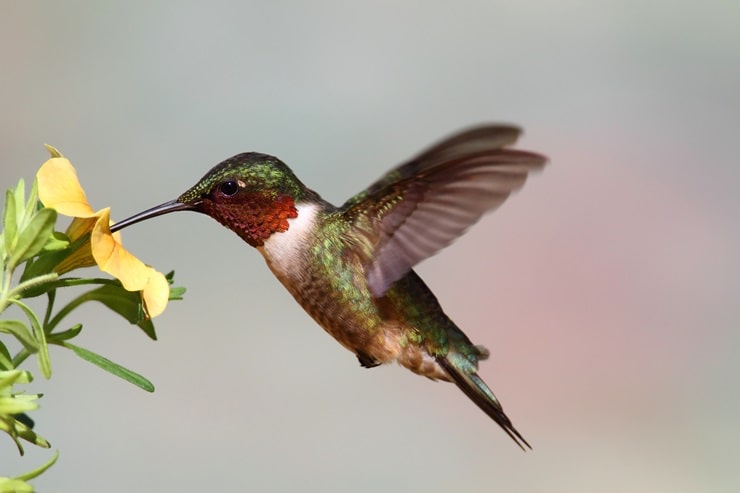
- Scientific name: Archilochus colubris
- Size: 2.8-3.5 inches long
- Weight: 0.1-.02 ounces
- Wingspan: 3.1-4.3 inches
Say “hello” to the most common – by far – hummingbird in all of Wisconsin. In fact, this is the only breeding hummingbird in the eastern part of North America, and the only non-migratory hummingbird in the state.
The male birds are easy to identify by their bright red throats. If you notice a bird that looks somewhat like a ruby-throated, but the throat looks dark red, it’s likely just because the feathers aren’t in good light. Wait until the sunlight hits them, and you’ll see that shining bright throat.
Otherwise, these birds are emerald or golden-green on their backs and grayish-white on the underside. The beaks are black.
These bold birds are frequent visitors to feeders and if you have the chance to watch their antics, take it. They are incredibly agile. They can stop instantly in the air, hover up, down, side-to-side, and backward. Not only do they feed at feeders and in tubular flowers, but they’ll snatch insects out of the air or from webs, as well.
These generalists live in parks, gardens, backyards, meadows, fields, forests, and woodlands.
They fly away in the fall to winter in Central America and they actually fly across the Gulf of Mexico in one single flight without stopping. Very impressive!
When Do They Arrive In and Leave Wisconsin?
Ruby-throated hummingbirds are the only non-migratory hummingbirds in Wisconsin. They prefer warmer regions, but they aren’t scared to hang out even in the colder months.
You can see them most often during the breeding season throughout Wisconsin, which takes place from March to July, but they might be found any time of year.
2. Broad-Billed Hummingbird
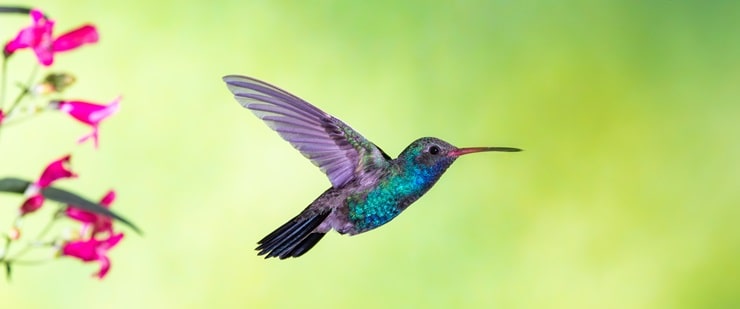
- Scientific name: Cynanthus latirostris
- Size: 3.5 inches long
- Weight: 0.1 ounces
- Wingspan: 4.3 inches
The broad-billed hummingbird makes Mexico and a few parts of the Southern US such as Arizona and New Mexico its home. It stays year-round in Mexico, but ventures further north during the breeding season.
This bird has a long, narrow, straight bill and a tail with a notch at the center, which helps you tell it apart from other species. They also stand out because of their shimmering green bodies and blue throats on the males. The bills are red with a black tip.
They eat insects as well as the nectar from flowers and feeders.
These birds create their nests in mountain canyons and then head to higher elevations to forage after raising their young. The males court the females with a swooping display that has been compared to the swinging of a hypnotist’s watch.
There are five sub-species but only the magicus sub-species live in the US.
When Do They Arrive In and Leave Wisconsin?
Look for them during the summer.
3. Anna’s Hummingbird
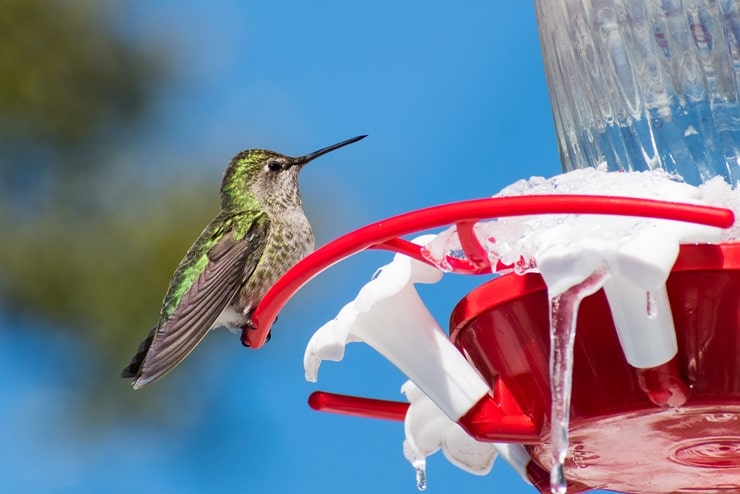
- Scientific name: Calypte anna
- Size: 3.9 inches long
- Weight: 0.1-0.2 ounces
- Wingspan: 4.7 inches
If you live along the Pacific coast, then no doubt you’ve seen the stunning Anna’s hummingbird. They’re one of the most common species in the region and they live there all year long. They’ll also travel inland a bit during the breeding season and some will migrate to Mexico during the non-breeding season.
Look for the greenish-gray birds with iridescent feathers. Males have reddish-pink chins and heads.
When they’re breeding, the males will swoop down up to 130 feet, making a buzzing noise with their tail feathers in an attempt to impress the females.
These birds are bold and curious and will come right up to humans to check them out. They’ll eat at feeders, snatch insects, and suck the sap of tubular flowers.
When Do They Arrive In and Leave Wisconsin?
If you live in Wisconsin, summer is when you might be able to spot them. They’re an accidental visitor and have only been seen a few times in Wisconsin.
4. Green-Breasted Mango
- Scientific name: Cynanthus latirostris
- Size: 3.5 inches long
- Weight: 0.1 ounces
- Wingspan: 4.3 inches
You’d probably never describe a hummingbird as chunky, but the green-breasted mango is relatively bulky. Its coloring somewhat resembles an oil slick, with iridescent black, green, purple, and blue feathers mottled throughout. Females have white tail corners.
These birds live in Mexico and Central America, but they are known to wander about. They’re often seen along the Gulf Coast of Texas, but rarely, they will venture even further north into states such as Louisiana, Georgia, and as far as North Carolina and even Wisconsin.
They’ll visit hummingbird feeders and they favor tropical flowers, especially those from large-flowered tropical trees like Inga and Erythrina species.
When Do They Arrive In and Leave Wisconsin?
Since they’re an accidental visitor to Wisconsin, you never know when they’ll show up, but summer is the most common time.
5. Mexican Violetear
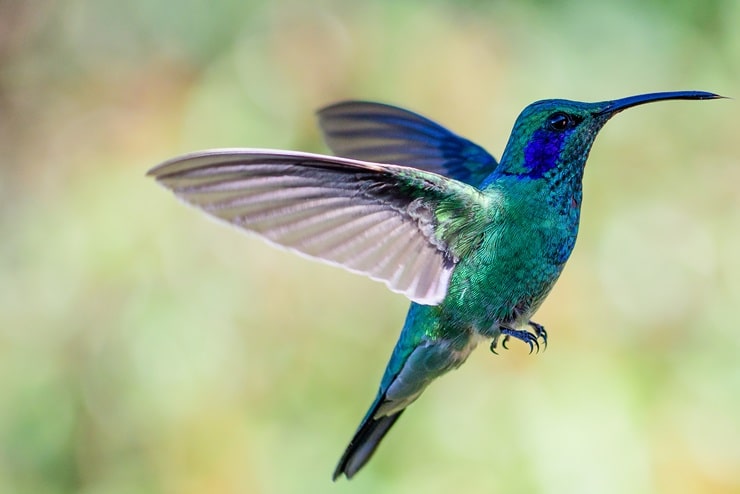
- Scientific name: Colibri thalassinus
- Size: 5.25 inches long
- Weight: 0.21 ounces
- Wingspan: 4.25 inches
Formerly known as the green violet-eared hummingbird, these are large for hummingbirds and can be nearly five-and-a-half inches long. Combined with their bright green bodies and violet streaks on the chest and cheeks, it’s easy to spot them as they flit about pine forests and roadsides.
They will visit birdfeeders, but they like to stay hidden as they eat, so if your feeder is out in the open they might not hang out much.
Their populations are concentrated in the southwest US and all of Mexico down through parts of Central America, but these birds are wanderers. You’ll find them as far north as Canada and occasionally across the midwest and Atlantic Coast.
When they pop up in states like Wisconsin, it’s known as an “accidental” visit. It doesn’t mean that the bird didn’t know where it’s going, though. It’s just a term that birders use to describe a species that visits an area where they aren’t normally seen.
When Do They Arrive In and Leave Wisconsin?
There’s no telling when you might see a Mexican violetear, but watch for them primarily during the summer.
6. Rufous Hummingbird
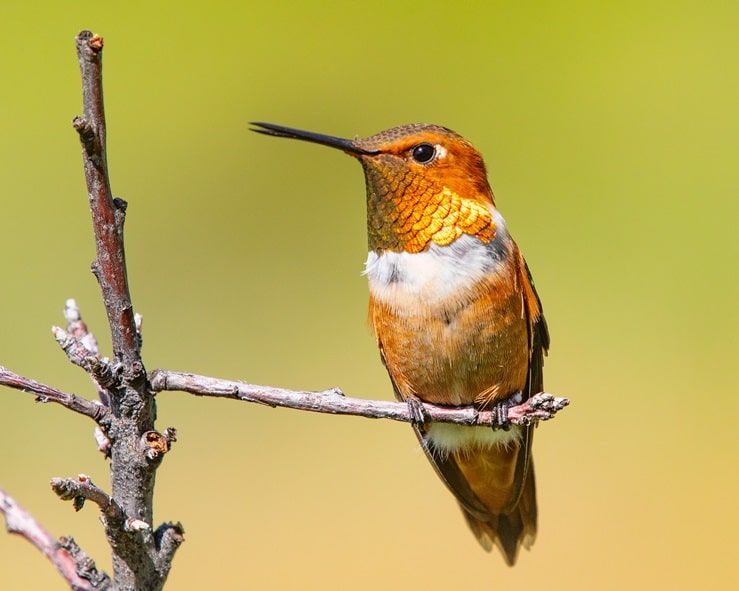
- Scientific name: Selasphorus rufus
- Size: 2.8-3.5 inches long
- Weight: 0.1-.02 ounces
- Wingspan: 4.3 inches
Rufous means “reddish” and that’s what these birds are. When the sunlight hits them, they glow like a lump of burning coal, with a reddish back and a vivid red throat. The females have a little bit of green on their tails and flanks, plus a little spot of orange on their throats.
Even though these birds might just be visiting an area as they migrate, they’re fierce defenders of the area they are in. They will tirelessly chase off any hummingbird that dares come near. They’ll even chase off bigger birds of other species and they’ll dive-bomb humans who come too close to their feeder or nest.
Like ruby-throated hummingbirds, they’re incredibly agile and will feed from feeders and tubular flowers, as well as snatch insects from the air or spider webs. They live in backyards, forests, meadows, and parks.
In the spring, they leave to their breeding grounds on the west coast where they stay from April to July.
When Do They Arrive In and Leave Wisconsin?
These hummingbirds aren’t common in Wisconsin. They usually pass through in the fall as they head from the Rocky Mountains to the Gulf Coast.
How to Attract Hummingbirds
To attract hummingbirds to your yard, pick feeders that have a little perch so you can observe them holding still as well as in flight.
Contrary to common belief, the feeder doesn’t have to be red. These birds don’t care about the color, they just want a nice meal. You can grab a beautiful feeder with perches from Bolite. Don’t die the nectar, either. Clear nectar is totally fine.
You can also use pre-made nectar to attract them. Just be sure to change the nectar frequently and wash the feeder out with hot water and soap. When it’s really hot, you should change your feeder daily. During cooler weather, once a week is fine.
Feeders left uncleaned develop a mold that can kill hummingbirds.
Some experts also recommend that you put your feeders away in regions that get cold during the winter so you don’t accidentally entice tropical birds to stick around during the winter.
You should also plant stuff like firebush, fuchsia, honeysuckle, cardinal flowers, fire pink, wild bergamot, columbine, red buckeye, trumpet vine, and powder puff trees. Hummingbirds love these.
Other Species of Birds in Wisconsin:
Woodpeckers in Wisconsin
Owls in Wisconsin
